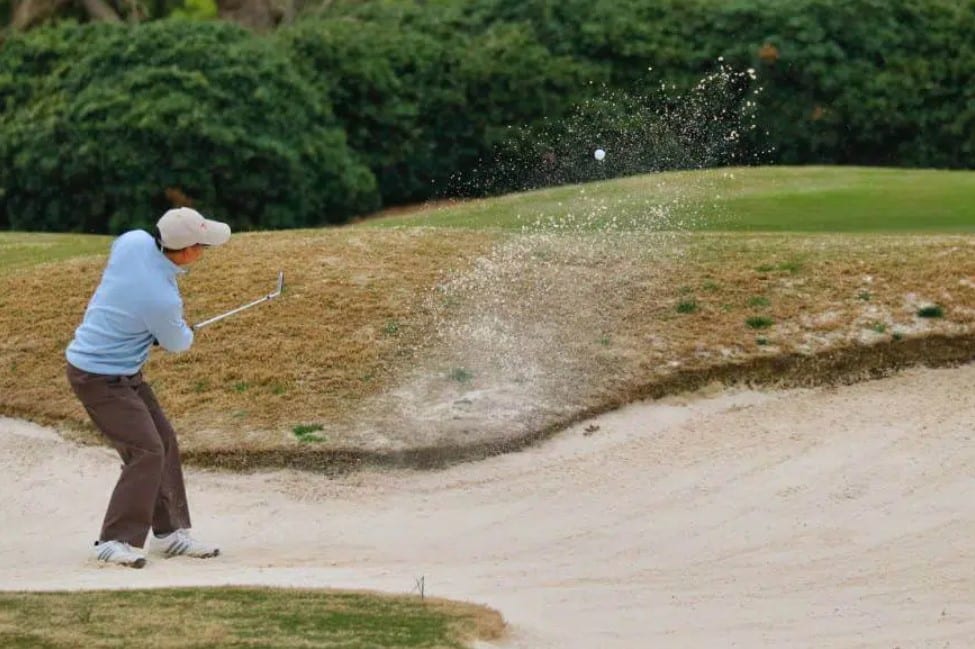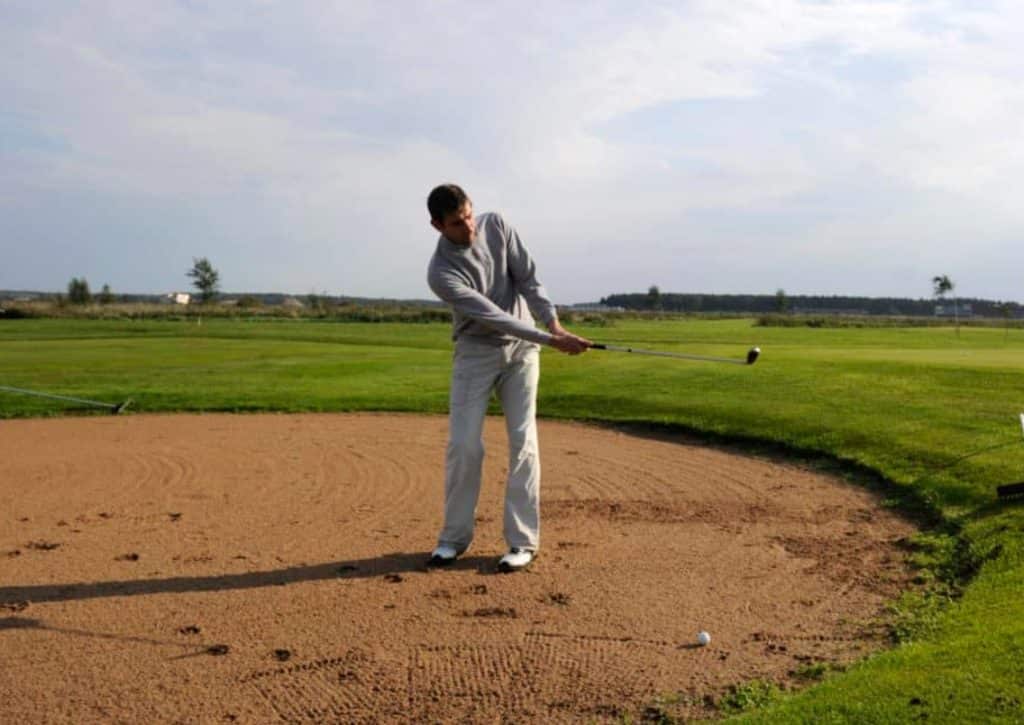Do you need clarification on whether you require a lower or higher bounce for your golf performance?
If yes, you should pick the suitable bounce angle for your sand wedge to make your performance satisfactory.
Remember to consider the importance of bounce angle for your sand wedge because it can influence your golf play immensely.
Choose a 10-degree bounce sand wedge if you often play in firmer turfs. On the other hand, pick a 14-degree bounce wedge if you frequently play in soft fairways.
Assuredly, you’ll be more confident knowing you have the appropriate wedge to help you play outstandingly around the golf course.
Learn more about sand wedge bounce 10 or 14 and uncover their differences below.
Which Should I Use: A 10 or 14 Degree of Bounce Sand Wedge?
Do you play on fairways with more rigid surfaces and are likely to take the ball when making contact? If you are, the suitable sand wedge bounce you should get should be nearly 10 degrees.
Meanwhile, do you play on fairways with smooth conditions and are likely to make divots after contact?
If yes, it’s best to go for nearly 14 degrees of bounce when picking sand wedges.
Selecting The Appropriate Bounce For Your Playing Style
Choosing the suitable sand wedge for your golf performance is an indispensable component of golf play. You’re aware that you encounter different golf course conditions, so being ready is crucial.
8 to 12 degrees of bounce is the standard sand wedge. Its primary purpose is to aid all golfers in dealing with board rough and sand bunkers.
It would help if you made slight changes to your sand wedge’s bounce angles to suit your playing style.
When Should I Select A High-Bounce Sand Wedge?
Sand wedges with higher bounce are foolproof options when playing in soft sands.
Pick sand wedges with 10 or 14 degree bounce angle if:
- You play on golf courses with softer playing situations
- You’re likely to strike at the rear of the golf ball on your mis-shits.
- You want to gain confidence in getting the ball higher.
- You’re likely to create profound turfs after contact or have a high golf swing.
- You don’t want to change your club face.
When Should I Select a Low-Bounce Sand Wedge?
As a general rule, you may go for low-bounce or 6 to 10° sand wedges if:
- You play on the course with hard or thick bunkers and harder sand or ground.
- You don’t create several turfs after contact or have a depthless swing.
- You prefer versatile wedges that expedite the club face.
How Does Bounce Affect A Sand Wedge?

Typical sand wedges have between 10 and 14° of bounce. With ample bounce, the club glides through the sand smoothly and doesn’t stick or dig down into the sand.
The Type of Bounce Used For Different Course Conditions
You can use a sand wedge with more than 10° of bounce, preferably a 12-degree bounce in several conditions.
However, it’s still vital to know when to utilize specific wedges, particularly with a 56-degree wedge.
Your shot may necessitate a unique bounce angle that could assist you in executing your shot excellently in different courses.
Here are the different types of bounce used for diverse course conditions:
1. Heavy Rough
Use a sand wedge with a higher bounce if you want the club to glide beneath the dense grass. Using one with a lower bounce causes a lack of consistency in your game performance.
It’s best to use a wedge with a 12 to 14 bounce angle, especially if you play in a dense rough.
2. Medium, Wet and Firm Sand
Less bounce in this course condition is better since the sand won’t let the fat sole penetrate deep enough.
Due to this, there’s sufficient space to bounce, so it’s painless to blade the ball across the greens.
Utilize a sand wedge with a mid-bounce of 8 to 10° if you’re playing in firm sand and golf courses.
Nonetheless, wedges with a 10 to 12 bounce angle are recommendable if you’re playing in medium sand.
3. Soft Sand

Go for wedges with higher bounce if you’re playing on golf courses with soft sand. The goal of bunker shots is to glide the club beneath the ball.
Additionally, it aims to skitter that wedge to bounce higher and allow the ball out. You can perform successfully using a wedge with 12 to 14° of bounce.
4. Tight lies off the course
Wedges with 6 to 10° bounce angles are reliable when creating clear contact when opening the club face slightly.
You’ll score higher if you utilize higher bounce wedges since the leading edge meets the ball at the equator.
5. Medium to Hard Sand
Choose wedges with 8 to 10° bounce angles if you often play in courses with medium to hard sand.
These degrees’ bounce angles help your club lay flatter down at the ball, keeping bouncing off the ground from occurring.
How To Measure “Bounce” On A Sand Wedge?
You can measure the wedge bounce by gauging the angle between the trailing and leading edges.
It commonly lands between 0 degrees and 14°. For instance, measure the lowest point of the sole of your sand wedge.
The Best Company for Sand Wedge Alternatives
Here are a few reputable brands that you can check out when buying the appropriate sand wedge for your play:
- Callaway PM Grind
- Cleveland CBX Wedge
- Cleveland RTX 4 Sand Wedge
- Titleist Vokey SM6
- Cleveland Smart Sole 4 (superior bounce)
- Callaway Mack Daddy 4
FAQ’s
8 to 10 degrees is the ideal bounce for 52-degree sand wedges. A firm golf course and dense sand bunkers require low-bounce sand wedges.
Meanwhile, high-bounce sand wedges work exceptionally on soft sands and golf courses that aren’t firm.
Around 12 degrees is the ideal bounce for a 56° wedge. Golfers on different golf courses will enjoy their golf play with this bounce degree.
Eight loft degrees is deemed the approved bounce of the gap. Wedge firms offer equivalent grind alternatives so that players can select gap wedges featuring low or high bounce.
Countless golfers prefer using sand wedges on the golf course. Sand wedges with higher bounce offer more forgiveness, particularly when creating contact with the ball.
Indeed, a high loft offers outstanding spin to ensure better control during golf play.
Yes. The 58° sand wedge is ideal if you’re having issues with sand shots or leaving the ball in the bunker.
Picking clubs with huge bounces is advantageous in playing bunker shots in sleeker and softer bunkers.
Pro golfers used wedges with a low bounce way back. However, the PGA Tour pros nowadays use versions with 12 or 13° of bounce.
Ten degrees of bounce is excellent for a sand wedge, making it ideal for regular bunkers and turfs.
It has a moderate attack angle, making it a perfect option for an extensive array of swing types.
That said, it’s unnecessary to modify your setup excessively to use the wedge in and surrounding the greens.
Yes. A pro golfer may have a wedge ground to modify its playing attributes to suit a specific golf course condition.
You can modify the wedge’s bounce by grinding the club head or softening or sharpening the leading edge.
It generally depends on what a golfer searches for when getting a sand wedge. For instance, if you intend to increase your distance control and spin, you’ll benefit from using 14°.
This bounce angle will also exceptionally execute in softer lies in bunkers. For this reason, considering the type of sand in the golf course where you’re playing is a must.
Famous golf product brands produce wedges designed with different bounce and loft options for golfers. This way, players can pick the suitable wedge that is best fitted for their golf game.
Remember, 14° is beneficial for lower handicaps since they can affect the acceptable margins of the game.
Sand wedges with 14 to 16° are ideal for soft or profound sand. Meanwhile, it’s best to use sand wedges with 8 to 10 bounce angles for compacted or thin sand.
Remember, low-bounce clubs are best for firmer turfs, while high-bounce options are more reliable on soft fairways.
Ten degrees or less is enough for firm bunkers. Nevertheless, you should get close to 14 degrees sand wedges if playing in soft, moist, and lush grass.
Final Thoughts
Besides the loft degrees of a club, the degree bounce angle of the wedge is critical to consider in golf.
Choosing sand wedge bounce 10 or 14 for your playing style is paramount to maximize your performance.
Different golfers usually use 10 or 14 degrees sand wedges since they’re ideal for diverse types of golfers.
Hopefully, this post gave you the necessary information about sand wedges to help you make better choices.
Remember, you can enjoy your golf experience more if you pick the right degree of bounce for your sand wedge.
Matt Stevens is the founder of Golfrough.com. He holds a Postgraduate in Sports Marketing and has played golf since he was four years old. Having experienced every high and low golf has to offer, his writing helps the average golfer avoid the mistakes he has made in 28-years on the course.

